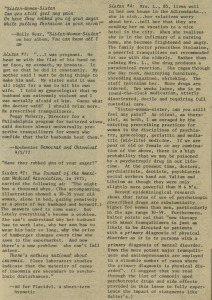In volume three, issue nine of New Woman’s Times, readers – referred to as “sisters” – of the periodical write in to narrate their experiences with prescribed tranquilizers to warn other readers about both the drugs and the physicians who attempt to prescribe them. A pregnant “Sister #1,” after having been beaten by her husband, tells her gynecologist about the domestic abuse she has suffered, only to be told by the physician to “relax more” as she is written a prescription for tranquilizers (Sojourner 8).

Three “sisters” describe their experiences with prescribed tranquilizers in the article, “Sister – Woman – Sister” by Mary Sojourner, published in the September 1977 issue of New Woman’s Times.
In addition to compelling graphic imagery, the anecdote offered by “Sister #1” increases its persuasiveness through the inclusion of an expert opinion: “Peggy McGarry, Director for a Philadelphia program for battered wives, said doctors almost universally prescribe tranquilizers for women who confide that their husbands beat them” (8). Following the story of “Sister #1,” “Sister #2” reports on an ad for Placidyl, a “short-term neurotic,” which describes a woman overwhelmed by all of life’s difficulties (8). “Sister #3” struggles with romantic troubles and depression, followed by an episode of shock after her psychiatrist neglects to warn her not to drink alcohol while on prescribed Valium and Triavil (8). Finally, “Sister #4” describes a friend of 85 years, who was sent to a nursing home despite her protests and drugged with “Stelazine, a powerful tranquilizer not recommended for use with the elderly” until her eventual death from overdose (8). These anecdotes, accompanied by an article that elaborates on the culture of drug pushers from advertisements to physicians, personalize issues of addiction and inform the audience of the threat of tranquilizers.
Work Cited:
Sojourner, Nancy. “Sister – Woman – Sister.” New Women’s Times, vol. 3, no. 9, Sept.-Oct. 1977, pp. 8-10. JSTOR, www.jstor.org/stable/community.28041298.
